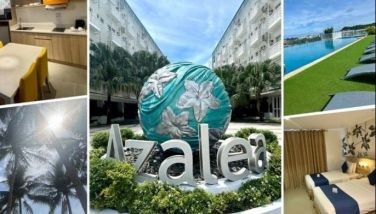150 years of Gaudi
September 7, 2002 | 12:00am
 Many writers have already talked about and are still talking about our negligence of the country’s historic public buildings. One of these is the Metropolitan Theater, an Art Deco building with a colorful facade, across the Neoclassical post office building in Plaza Lawton, Manila. It is now faded and derelict. Designed by Juan Arellano, the Met Theater was inaugurated in 1930.
Many writers have already talked about and are still talking about our negligence of the country’s historic public buildings. One of these is the Metropolitan Theater, an Art Deco building with a colorful facade, across the Neoclassical post office building in Plaza Lawton, Manila. It is now faded and derelict. Designed by Juan Arellano, the Met Theater was inaugurated in 1930.
Younger Filipinos may have known about it when Vilma Santos used to broadcast her popular television show from there in the late ’80s. The Met was restored in 1978 at the initiative of then First Lady and Metro Manila Governor Imelda Romualdez Marcos. Recently, President Gloria Macapagal-Arroyo declared her support for the Met Theater’s revival after having languished in a legal dispute between the City of Manila and the Government Service Insurance System (GSIS).
Were you not preoccupied dodging the vehicles weaving in and out of traffic, you might have noticed the details that contribute to its unusual façade. There are the decorative stained glass windows ornately spelling out the theater’s name, as well as the grill work that blends the geometric lines with the curved corners and tropical flora. Looking closer, you will see the mottled pale colors that resemble lichens covering the walls.
When I began watching plays there in the early 1980s, I always wondered about its brilliant coat on both the outside and inside of the building. I remember even going near and touching its interior walls while waiting for a play to start. It is a shame that only a few Filipinos now have memories of and a chance to experience being in its wonderful space and appreciate its architecture.
Many years later, I found that the idea for façades painted with mottled, pale multicolored patterns had its roots in the Modernist movement in Europe. For instance, there’s an affinity between the walls of the Met Theater and that of Casa Battló, which is a remodeled block of apartments by Antoni Gaudi, the renowned Catalan master builder. Besides the vivid texture and color of its walls, Casa Battló also features a bone-like articulation of curvilinear stone columns, mask-like iron balustrades and polychrome ceramic roof that resemble the tail of a mythological dragon.
This year is the 150th year of Gaudi’s birth and has been declared by the Catalan and Spanish governments as International Gaudi Year. In Spain, particularly in Barcelona, more than a hundred events are being held including a series of symposia, exhibitions and a conference devoted to the pious Catholic man who loathed much attention. Of the major architecture Gaudi made, 11 are in Barcelona, one just 20 kilometers from the city, one in Santander and two in Leon. All his three structures included on UNESCO’s World Heritage List are in Barcelona. There are no Gaudis outside Spain.
Gaudi left his unusual architecture around the city and his buildings now attract the attention of more than two million people a year. Many of them come to Barcelona to either admire or scorn his work. The Catalan region also boasts other world-famous artists, including Pablo Picasso, Joan Miró (Joan is Catalan for Juan), Antoni Tapies and Salvador Dali. The first three have their museums in Barcelona while Dali’s is at Figueras in the southeastern region. Those who have spent holidays in Spain warned us that going there during the European summer is a bad time since droves of tourists are expected. But we eventually discovered for ourselves that Barcelona manages its guests quite well and that it would have been a pity to miss the Spanish sun at its best, beating on Gaudi’s brilliant architecture.
One of those that photographs cannot quite capture and has to be seen is the shimmering Casa Battló with its stucco façade. Besides the magnificent daylight, the brilliance of the building comes from the trencadís or the embedded ceramic shards that Gaudi incorporated in his other designs. For instance, in the city-garden, the Park Guell has a long, sinuous bench with close trencadís cladding. Many of his façades are also broken up by waves, vines and other protrusions.
Moreover, he used fragments of bottles as decorations for masonry or plain surfaces. This and the trencadís are the outcome of his ascetic ways which include recycling building and decorative materials. A friend with whom I walked around the various Gaudi sites noticed that the sensibility of using broken glass is "very Third World in an artistic way." In addition, Gaudi made asymmetrical building designs that ultimately look stable when adorned with other building materials or color. Bringing in light and air is important to Gaudi and many of those features such as niches, balconies, skylights and ventilation towers affected his design of peculiar buildings.
Architectural elements found in Gaudi’s structures are manifestations of what is now known as Modernismo, occurring simultaneously with Art Nouveau in that region. It came at a time when from 1859, the Catalans were able to define their identity through the expansion of their urban landscape beyond the old quarter. A long diagonal avenue, Avinguda Diagonal, bisects the grid plan of the city streets. Gaudi interrupted this symmetry by providing astonishing architecture for clients with property in the center of town. A critic called them "whiplashes" because people on the lookout keep turning their heads as they cruise along Barcelona’s wide avenues. At the turn of the century, when Gaudi was at his most active, the Catalan middle classes had money to support ebullient and symbolic architecture. Their built heritage marked their distinctiveness.
Gaudi was fortunate to have had the patronage of industrialists, including businessman Eusebi Guell who allowed him to design four of his properties around Barcelona. He also had the support of architects, sculptors and craftsmen he collaborated with and ultimately inspired. A particularly interesting collaboration is with architect Josep Maria Jujol. One of their more famous works is at the Casa Mila (1906-1910), named after its patron Roser Segimon de Mila. Jujol directed the construction of the chimneys and ventilators on the roof while the master builder was busy with another project.
Despite all these building activities, Gaudi was not always praised during his lifetime. An indication is the unflattering nickname given by Catalans to Casa Mila: La Pedrera, meaning "the quarry." Standing at the corner of Passeig de Gracia and Carrer de Provença, it is a monument to innovation and modernism. This is represented by the curvilinear façade with large windows to allow light to enter the rooms. Early cartoons of it drawn with cannons sticking out reveal how much Gaudi’s critics reviled it then.
In La Pedrera, Gaudi introduced lifts to provide access to the apartments and eliminate the residents’ staircase. There are no straight lines in the patios or interiors or on the undulating stone facade. It has also one of the first underground parking areas for carriages and automobiles that were accessed by helicoidal ramps. Today, the renovations reveal the compromise between a residential building and a World Heritage site.
Its attic, for instance, houses the Espai Gaudi (or Gaudi Space), which is the visitor information center, providing, among others, a complete view of the architect’s life and work and artistic features he introduced. People still live in the apartments below it.
In the Gaudi Space is a reconstruction of the stereo funicular studies he made to construct another commissioned architecture, the Crypt in Colonia Guell. The studies were the architect’s methods of determining the form of the structure for the space without mathematical formulas. The curve adopted by a chain defines the shape of each arch. The chain is suspended from the two extremes and hung with weights equivalent to the loads to be supported by the finished arch. Its mirror image provides the view of the structure in its final position.
Somehow his method has made me appreciate more some of his monumental buildings, such as the Neo-Gothic Sagrada Familla (Holy Family). It is an original development of ruled geometry and clever application of decorative elements. Gaudi worked on it for 40 years, from 1883 until a tram struck him on his way to church in 1926. Only one steeple had been completed before he died three days after the accident. He designed the steeples to lighten and stylize the bulk of the building. His collaborator Domingo Sugrañes immediately completed the remaining three after Gaudi’s death and by 1933, the Nativity façade was finished. With its overloaded decorative style, critics consider the church and similar Gaudi edifice kitsch. No matter, this yet unfinished church (estimated to be completed in 2030) and the school at its foot have influenced many modern and contemporary architects, including Norman Foster.
The same friend observed that it’s amazing how the series of historical events led to Barcelona being the only city with Gaudi’s most important architecture. Virtually immovable, permanent and easily attractive to tourists, they are an inspiration to the steady stream of visitors. Gaudi’s powerful influence in modern architecture in different parts of the world made it possible for some of his design elements to appear even in our local buildings.
The Met Theater’s decoration seems colorless compared to the Casa Battló, more so now that it has been left to decay by government agencies that take their time to restore it even with presidential go-ahead for its resuscitation. Filipinos can learn a few things from the Catalans, particularly how the preservation of historic buildings results in developing cultural identity. These may raise pride about the people’s past and their distinctiveness, even if sometimes their designs stir passionate debates. Architects like Gaudi and Arellano enabled these through their legacy of built environment. It is up to us to maintain these markers against cultural amnesia by beginning to fully appreciate the architects’ artistic heritage. We can start by opening our eyes and learning to see what we are looking at.
If you cannot go to Barcelona, see the International Gaudi Year site at www.gaudi2002.bcn.es.
BrandSpace Articles
<
>




















